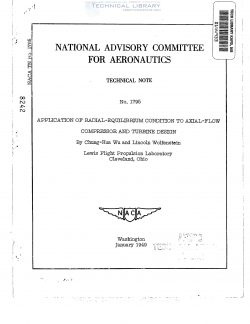naca-tn-1795
- Version
- 110 Downloads
- 2.77 MB File Size
- 1 File Count
- December 8, 2016 Create Date
- December 8, 2016 Last Updated
National Advisory Committee for Aeronautics, Technical Notes - Application of Radial Equilibrium Condition to Axial Flow Compressor and Turbine Design

Basic general equations governing the three-dimensional compres-
sible flow of gas through a.compressor.or a turbine are given in
terms of velocity components, total enthalpy, and entropy. These
equations are used to determine the radial motion of gas through an
axial-flow compressor or a turbine and the corresponding effect on
the radial variations of the state of gas between successive blade
rows in the case of steady, axially symmetrical flow. The aspect
ratio of the blade row is found to be an important factor in the cal-
culation when the effect of radial motion is included. The usual
method, which neglects the effect of radial motion, is shown to be
good only for the limiting case of zero blade-row aspect ratio, that
is for the case where the axial length of the blade row is much
larger than the radial length of the blade row. A sinusoidal radial-
flow path is found to give the effect of radial motion on the radial
variation of gas. state between blade rows as small as likely without
any discontinuity in the curvature of the streamline and is sug-
gested for use in design calculations.
The equations are applied to investigate the maxim compatible
number of the radial variations of the gas properties between
successive blade rows that a designer is free to specify. The vari-
ous ways of taking up these degrees of freedom and the different
types of design obtained are discussed. A general procedure is given
to calculate the characteristics of a compressor or turbine of any
given type of design, taking into account the effect of radial
motion of gas. Numerical calculations made for two types of com--
pressor and one type of turbine show that even in the case of non-
tapered passage, there is appreciable radial motion and that the
corresponding effects are of significant magnitude and should be
taken into account in design.
The design of a compressor or a turbine hereinafter called a
turbomachine may be divided into two phases. The first phase con-
cerns the type of design to be used or the determination of the
most desirable variations of velocity and thermodynamic properties
of the gas in planes normal to the axis of the machine between
successive blade rows. The second. phase concerns the design of
blades that will give the desired variations of velocity and other
properties of gas in these planes. In the first phase, the condi-
tion of radial equilibrium, that is, the radial component of the
equation of motion, must be used. The flow of gas in a turbo-
machine is curvilinear; it is curved not only by the whirling
motion of gas, but also by the radial motion of the gas. The equa-
tion of motion then specifies the radial pressure gradient required
to provide the centripetal force to maintain the curved flow.
| File | Action |
|---|---|
| naca-tn-1795 Application of Radial Equilibrium Condition to Axial Flow Compressor and Turbine Design.pdf | Download |

Comment On This Post